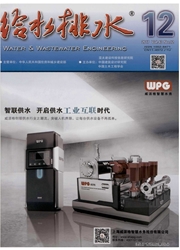

 中文摘要:
中文摘要:
通过进行预臭氧化-紫外线联合氯消毒工艺处理高温高藻期滦河水的生产性试验,检测和分析三卤甲烷生成势(THMFP)和卤乙酸生成势(HAAFP)的含量变化情况,研究了整套水处理工艺,尤其是预臭氧化单元对氯消毒副产物(DBPs)的去除效果。同时,研究了甲醛和溴酸盐这两种臭氧化副产物在处理过程中的生成情况。结果表明:在高温高藻期,预臭氧化单元对THMFP和HAAFP的平均去除率分别为12.43%和15.06%,整套工艺对THMFP和HAAFP的平均总去除率分别为39.339/6和54.129/6,氯消毒副产物前体物得到有效去除;出水中甲醛含量低于50μg/L,溴酸盐的含量小于6μg/L,臭氧氧化副产物得到了有效控制。
 英文摘要:
英文摘要:
A full-scale study was done on the processes of pre-ozonation and a combination disinfection of ultraviolet and chlorine to treat the Luan River raw water in high temperature and high algae concentration phase. Through the testing and analyzing of the trihalomethanes formation potential (THMFP) and haloacetic acids formation potential (HAAFP) variances, the whole set of water treatment process was studied, especially the effects of pre-ozonation on disinfection byproducts (DBPs) removal. At the same time, the formation of formaldehyde and bromated in treatment process was also studied. The results showed: during high temperature and high algae concentration period, the average removal rates of THMFP and HAAFP by pre-ozonation were 12. 43% and 15. 06% respectively, and the removal rates of combined process were 39. 33% and 54. 12% respectively, which meant the precursors of DBPs were removed effectively; formaldehyde and bromate in effluent were less than 50 μg/L and 6 μg/L respectively, which meant the DBPs were also controlled effectively.
 同期刊论文项目
同期刊论文项目
 同项目期刊论文
同项目期刊论文
 期刊信息
期刊信息
